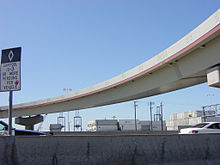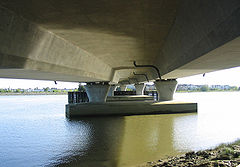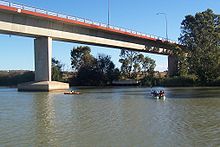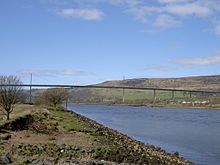- Box girder bridge
-
Box girder bridge
Underneath the No. 2 Road Bridge in CanadaAncestor Tubular bridge Related jetway, skyway Descendant Cable stayed bridge, segmental bridge, viaduct Carries Pedestrians, automobiles, trucks, light rail, heavy rail Span range Medium Material Steel, reinforced concrete, prestressed concrete Movable Possible Design effort High Falsework required Yes, if cast-in-place reinforced or prestressed concrete is used, which is typical for freeway overpasses  Single box girder bridge (steel), flyover above eastern approach of the San Francisco – Oakland Bay Bridge.
Single box girder bridge (steel), flyover above eastern approach of the San Francisco – Oakland Bay Bridge.
A box girder bridge is a bridge in which the main beams comprise girders in the shape of a hollow box. The box girder normally comprises either prestressed concrete, structural steel, or a composite of steel and reinforced concrete. The box is typically rectangular or trapezoidal in cross-section. Box girder bridges are commonly used for highway flyovers and for modern elevated structures of light rail transport. Although normally the box girder bridge is a form of beam bridge, box girders may also be used on cable-stayed bridges and other forms.
Contents
Advantages and disadvantages
Compared to I-beam girders, box girders have a number of key advantages and disadvantages. Box girders offer better resistance to torsion, which is particularly of benefit if the bridge deck is curved in plan. Additionally, larger girders can be constructed, because the presence of two webs allows wider and hence stronger flanges to be used. This in turn allows longer spans. On the other hand, box girders are more expensive to fabricate, and they are more difficult to maintain, because of the need for access to a confined space inside the box.
Construction
If made of concrete, box girder bridges may be cast in place using falsework supports, removed after completion, or in sections if a segmental bridge. Box girders may also be prefabricated in a fabrication yard, then transported and emplaced using cranes.
For steel box girders, the girders are normally fabricated off site and lifted into place by crane, with sections connected by bolting or welding. If a composite concrete bridge deck is used, it is often cast in-place using temporary falsework supported by the steel girder.
Either form of bridge may also be installed using the technique of incremental launching. Under this method, gantry cranes are often used to place new segments onto the completed portions of the bridge until the bridge superstructure is completed.
Development of steel box girders
The box girder bridge was a popular choice during the roadbuilding expansion of the 1960s and many new bridge projects were in progress simultaneously. A serious blow to this use was a sequence of three serious disasters, when new bridges collapsed in 1970 (West Gate Bridge and Cleddau Bridge) and 1971 (Koblenz Bridge). Fifty-one people were killed in these failures, leading in the UK to the formation of the Merrison Committee[1] and considerable investment in new research into steel box girder behaviour.
Most of the bridges still under construction at this time were delayed for investigation of the basic design principle. Some were abandoned and rebuilt as a different form of bridge altogether. Most of those that remained as box girder bridges, such as Erskine Bridge (illus.), were either redesigned, or had additional stiffening added later. Some bridges were strengthened a few years after opening and then further strengthened years later, although this was often due to increased traffic load as much as better design standards. The Irwell Valley bridge of 1970 was strengthened in 1970 and again in 2000.[2]
Corrosion Concerns
Corrosion of the steel cables that provide the post-tensioning for box girder bridges has become a major concern. On December 13, 2009, the Indiana Department of Transportation (INDOT) closed the Cline Avenue (SR-912) bridge over the Indiana Harbor and Ship Canal after a routine inspection revealed significant corrosion of the steel tensioning cables and rebar within the box girders due to water seeping through cracks in the bridge deck. After determining the level of corrosion compromised the bridge's structural integrity beyond repair, INDOT decided to permanently close and eventually demolish the span.
References
- ^ Department of the Environment (Merrison Committee of Inquiry) (1973). Inquiry into the Basis of Design and Method of Erection of Steel Box Girder Bridges. London: HMSO.
- ^ Smith, D. A.; Hendy, C. R. (2002). "Strengthening of Irwell Valley Bridge, UK" (pdf). Bridge Engineering (Institution of Civil Engineers) 161 (BE1): 33–43. http://www.icevirtuallibrary.com/docserver/fulltext/bren161-033.pdf.
Categories:- Box girder bridges
- Bridges
Wikimedia Foundation. 2010.



